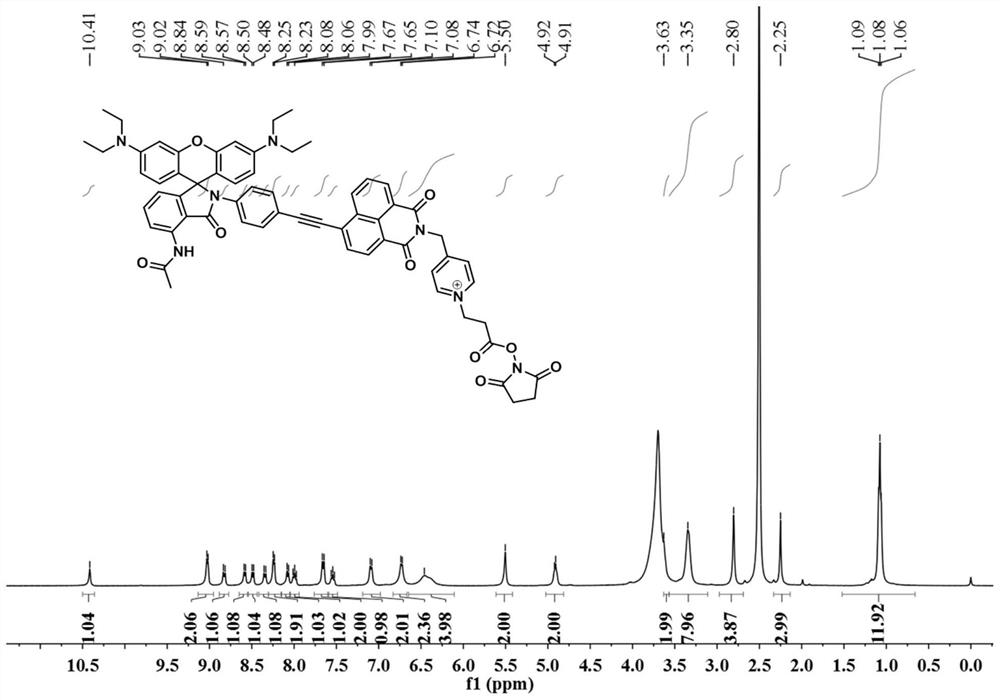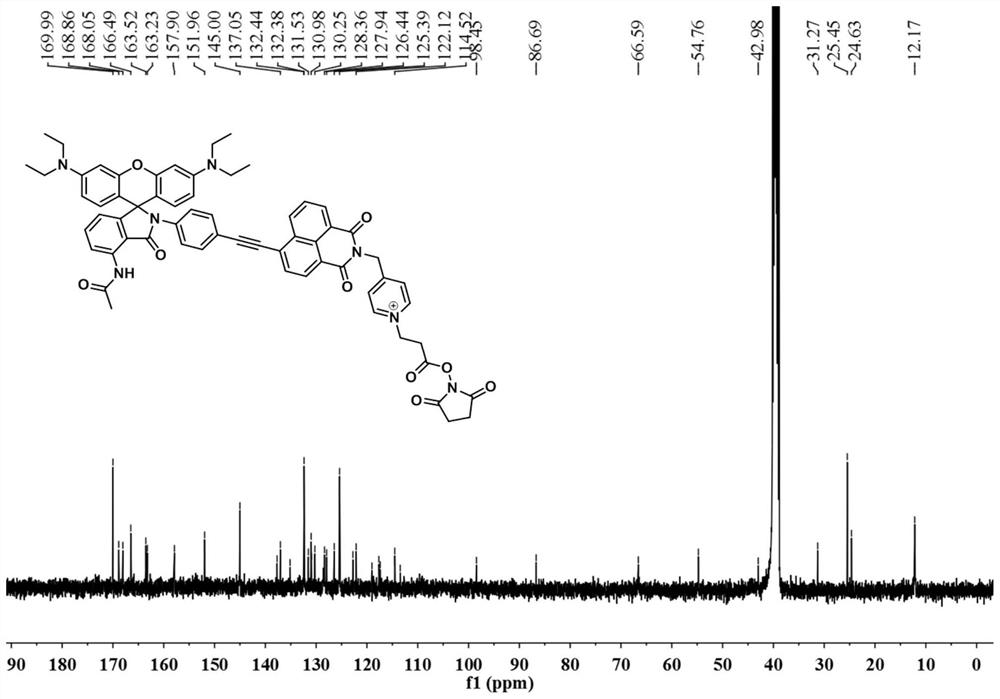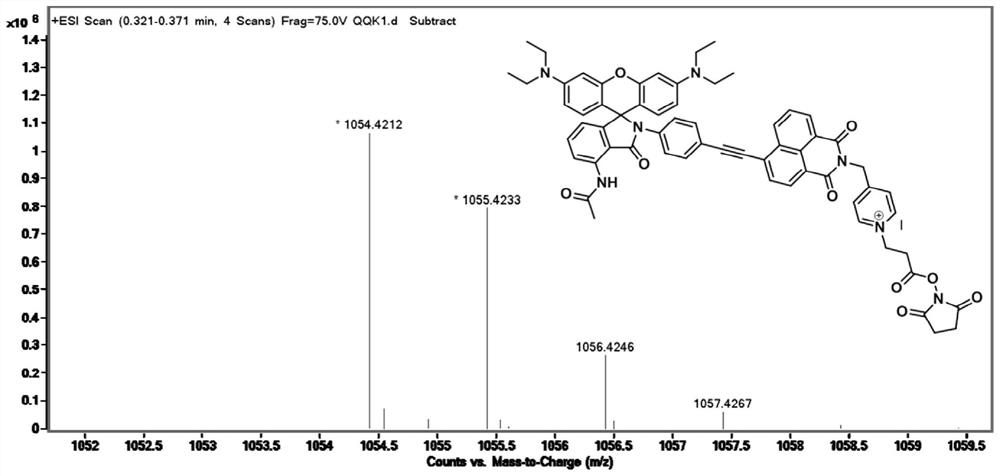A kind of acid-fast bacteria super-resolution imaging dye and its synthesis method and application
A technology of super-resolution imaging and synthesis method, which is applied in the field of fluorescent dyes and imaging, and can solve the problems of inappropriateness, acid-activated fluorescence interference, and biological phototoxicity unfavorable for live cell super-resolution imaging.
- Summary
- Abstract
- Description
- Claims
- Application Information
AI Technical Summary
Problems solved by technology
Method used
Image
Examples
Embodiment 1
[0024] Intermediate molecule (P1) synthetic route and product structure are as follows:
[0025]
[0026] Synthesis steps and characterization: 3-Nitrorhodamine (2.92g, 6mmol) and phosphorus oxychloride (5.6mL, 60mmol) were placed in 1,2-dichloroethane (150mL), heated to 84°C under reflux, stirred After 2 hours the solvent was evaporated to give a dark purple oily liquid. The crude acid chloride product was dissolved in dichloromethane (100mL), then added dropwise to a mixed solution of triethylamine (3mL) and 6-(4-aminophenylethynyl)naphthalene anhydride (1.88g, 6mmol), and stirred at room temperature for 24 hours Afterwards, the solvent was evaporated under reduced pressure, and the residue was separated by column chromatography (silica gel, dichloromethane / ethyl acetate, 30:1 v / v) to obtain a yellow powder product P1 (2.44 g, 52%). The yellow powder product was characterized by NMR and mass spectrometry:
[0027] 1 H NMR (400MHz, CDCl 3 )δ8.75(d, J=8.4Hz, 1H), 8.65(d...
Embodiment 2
[0030] Intermediate molecule (P2) synthetic route and product structure are as follows:
[0031]
[0032]Synthesis steps and characterization: P1 (1.56g, 2mmol), stannous chloride dihydrate (1.80g, 8mmol) and concentrated hydrochloric acid (9mL) were placed in absolute ethanol (50mL), heated to 78°C and refluxed, stirred for 8 After 1 hour, the solvent was evaporated under reduced pressure, and the crude product was separated by column chromatography (silica gel, ethyl acetate / petroleum ether, 1:3 v / v) to obtain yellow solid P2 (1.27 g, 85%). The yellow solid product was characterized by NMR and mass spectrometry:
[0033] 1 H NMR (400MHz, CDCl 3 )δ8.75(d, J=8.3Hz, 1H), 8.64(d, J=7.2Hz, 1H), 8.54(d, J=7.7Hz, 1H), 7.90(d, J=7.7Hz, 1H) ,7.85(t,J=7.8Hz,1H),7.44(d,J=8.5Hz,2H),7.22(t,J=7.7Hz,1H),7.13(d,J=8.6Hz,2H),6.76 (d, J=8.5Hz, 2H), 6.60(d, J=8.0Hz, 1H), 6.37(d, J=7.4Hz, 1H), 6.35–6.24(m, 4H), 5.44(s, 2H) , 3.32 (q, J=7.0Hz, 8H), 1.16 (t, J=7.0Hz, 12H). 13 C NMR (101MH...
Embodiment 3
[0036] The synthetic route and product structure of intermediate P3 are as follows:
[0037]
[0038] Synthesis steps and characterization: P2 (0.75g, 1mmol) and acetyl chloride (0.12g, 1.5mmol) were mixed in dichloromethane (10mL), stirred for 2 hours, and the solvent was evaporated under reduced pressure, and the crude product was passed through column chromatography (silica gel, Ethyl acetate / petroleum ether, 1:3 v / v) isolated the product P3 as a yellow powder (0.76 g, 96%). The yellow powder product was characterized by NMR and mass spectrometry:
[0039] 1 H NMR (400MHz, CDCl 3 )δ10.58(s,1H),8.75(d,J=8.2Hz,1H),8.65(d,J=7.2Hz,1H),8.55(d,J=7.7Hz,1H),8.51(d, J=8.2Hz,1H),7.92(d,J=7.7Hz,1H),7.90–7.82(m,1H),7.56–7.43(m,3H),7.00(d,J=8.5Hz,2H), 6.81(d, J=7.6Hz, 1H), 6.67(d, J=8.8Hz, 2H), 6.37–6.26(m, 4H), 3.33(q, J=7.0Hz, 8H), 2.31(s, 3H ), 1.17 (t, J=7.0Hz, 12H). 13 CNMR (100MHz, CDCl 3 )δ169.31,168.94,160.38,160.11,153.44,152.94,148.99,137.79,137.43,134.99,133.82,133....
PUM
 Login to View More
Login to View More Abstract
Description
Claims
Application Information
 Login to View More
Login to View More - R&D
- Intellectual Property
- Life Sciences
- Materials
- Tech Scout
- Unparalleled Data Quality
- Higher Quality Content
- 60% Fewer Hallucinations
Browse by: Latest US Patents, China's latest patents, Technical Efficacy Thesaurus, Application Domain, Technology Topic, Popular Technical Reports.
© 2025 PatSnap. All rights reserved.Legal|Privacy policy|Modern Slavery Act Transparency Statement|Sitemap|About US| Contact US: help@patsnap.com



